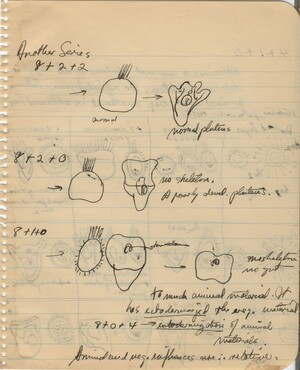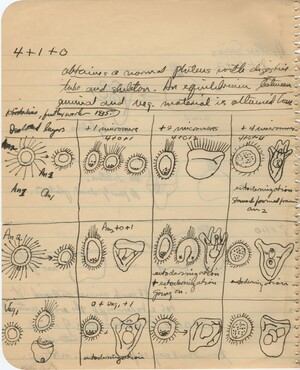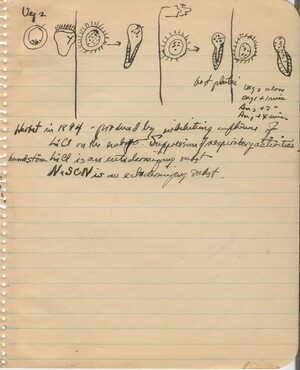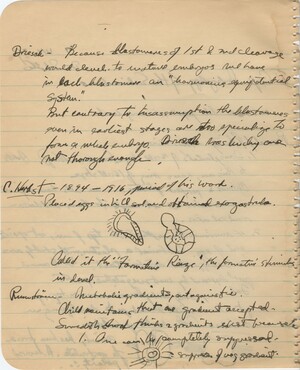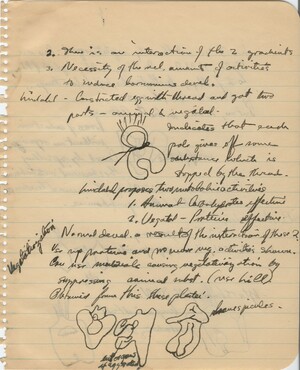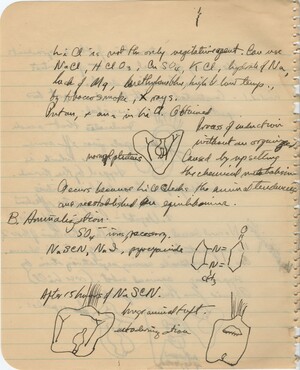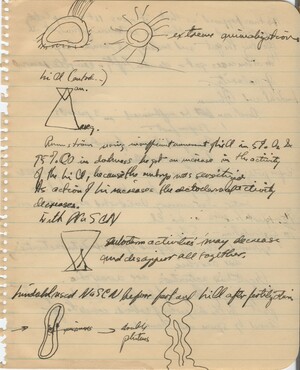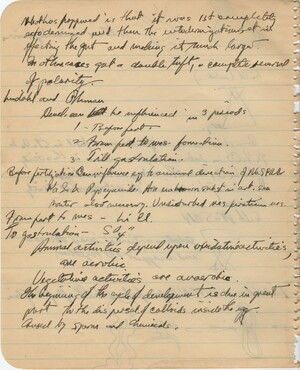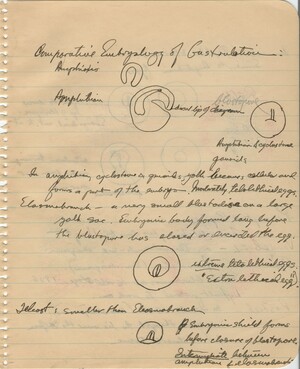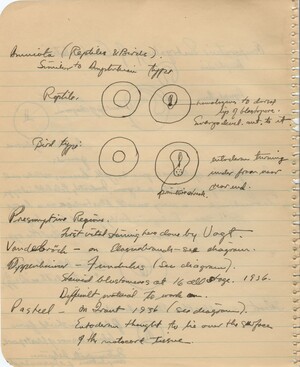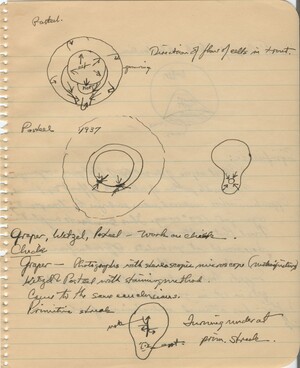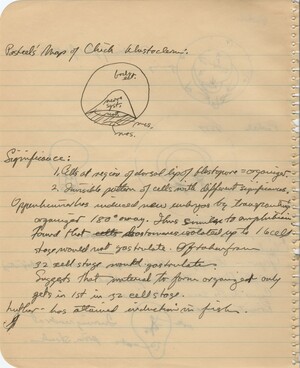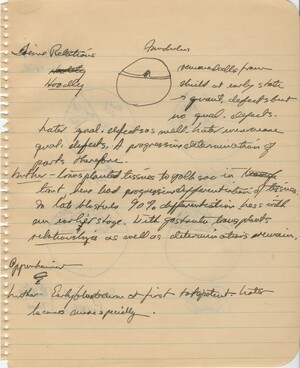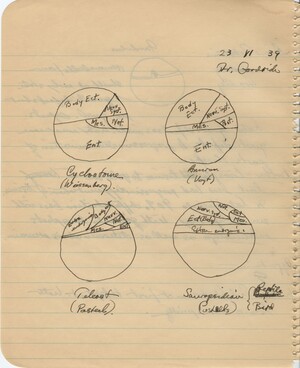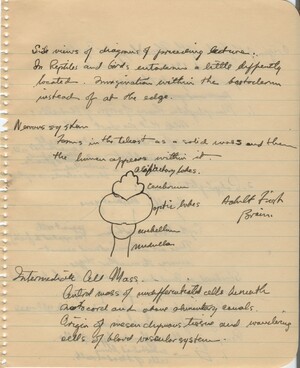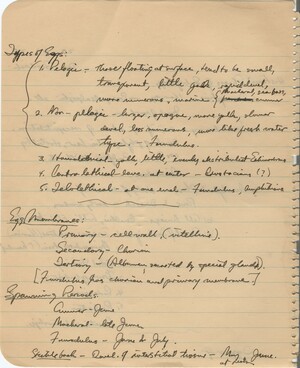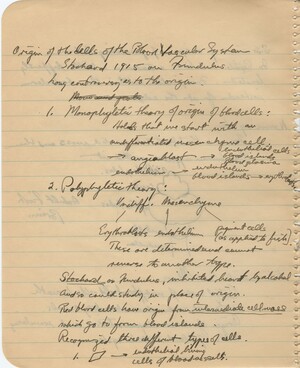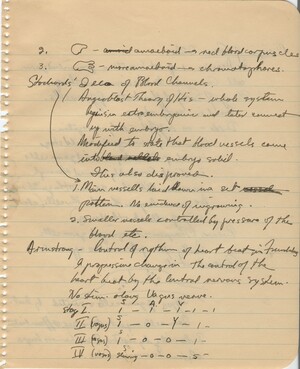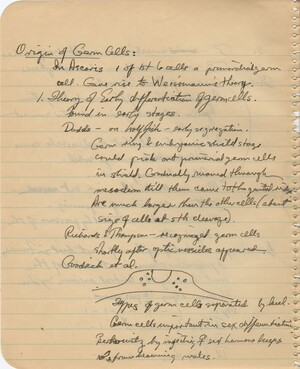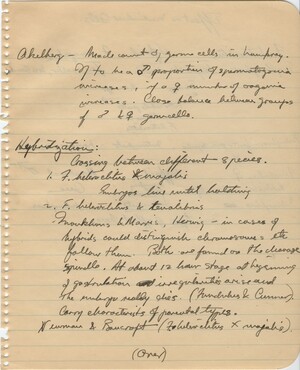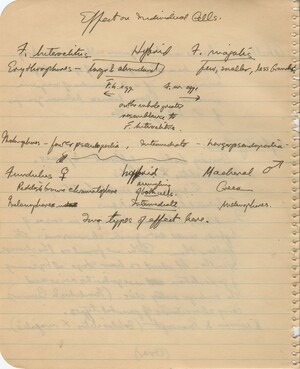Photographs
Notes from Oscar Schotte's lecture. Trinkaus continues his notes from the previous page on recombination experiments for the different cell stages (with diagrams)
Notes from Oscar Schotte's lecture. Trinkaus continues his notes from the previous page on recombination experiments for the different cell stages (with diagrams). Trinkaus creates an illustrated chart of Horstadius' different recombination experiments
Notes from Oscar Schotte's lecture. Trinkaus concludes his illustrated chart of Horstadius' recombination experiments and finishes the lecture notes with information on the effects of different chemicals on development
Notes from Oscar Schotte's lecture. Trinkaus begins notes on "Exp. Embryology of the Echinoderms" with an outline on "Reversal of Polarity" from Horstadius (inludes diagrams"
Notes from Oscar Schotte's lecture. Trinkaus takes notes on the experiments and theories of Driesch, C. Herbst (with diagram), and Rubstrom (with diagram)
Notes from Hubert Goodrich's lecture. Trinkaus continues notes from page 10. Including a diagram on concrescence and a chart that tracks temperature in cell numbers (y axis) over time (x axis)
Notes from Oscar Schotte's lecture. Trinkaus continues his notes on Runstrom's work from the previous page, then begins a section on Lindahl's egg constriction experiments (with diagram). Begins section on "Vegetalization" with information about normal development and the effects of different chemical compounds (with diagrams)
Notes from Oscar Schotte's lecture. Trinkaus continues his notes on vegetalization with information about the effects of different chemical compounds on development (includes diagram). Trinkaus begins new section, "Animalization" with several diagrams and information on different chemical compounds
Notes from Oscar Schotte's lecture. Trinkaus continues his notes on animalization with diagrams and information about different compounds (includes diagrams), and notes on Runstrom's and Lindahl's experiments
Notes from Oscar Schotte's lecture. Trinkaus continues his notes on Lindahl's experiments, and writes a lot about the effects of different chemicals on different stages of development
Notes from Hubert Goodrich's lecture. Trinkaus has drawn four colored diagrams of 'Presumptive Regions': Trout, Fundulus, Dog fish, and Urodele
Notes from Hubert Goodrich's lecture. Trinkaus begins notes on 'Comparative Embryology of Gastrulation' with notes and diagrams for amphioxus, elasmobranch, and teleost
Notes from Hubert Goodrich's lecture. Trinkaus continues notes on 'Comparative Embryology of Gastrulation' from page 13 with notes and diagrams for Amniota (reptiles and birds). Includes historical notes on Vanderbroeck, Oppenheimer, and Pasteel
Notes from Hubert Goodrich's lecture. Trinkaus continues notes on gastrulation from page 14. Includes a diagram of the 'Direction of flow of cells in trout' and a diagram on the formation of the primitive streak
Notes from Hubert Goodrich's lecture. Trinkaus continues cleavage notes from page 15 with a diagram of Pasteel's map of Chick blastoderm and notes on the signifance of this information.
Notes from Hubert Goodrich's lecture. Trinkaus makes notes on gastrulation in Fundulus, and transplantation experiments
Notes from Hubert Goodrich's lecture. Trinkaus draws four diagrams of gastrulation: Cyclostome (Weissenberg), Anuran (Vogt), Teleost (Pasteel), and Sauropsidian (Costello)
Notes from Hubert Goodrich's lecture. Trinkaus takes notes on the 'Nervous System' (with a fish brain) and the 'Intermediate Cell Mass'
Notes from Hubert Goodrich's lecture. Trinkaus' notes on 'Types of eggs', 'Egg membranes', and 'Spawning periods'
Notes from Hubert Goodrich's lecture. Trinkaus makes notes on the 'Origin of the Cells of the Blood Vascular System', including the 'Monophyletic theory of origin of blood cells' and 'Polyphyletic theory', with special reference to Stockard on Fundulus. Stockard recognized three different types of cells (with diagram): '1. endothelial living cells of blood vessels'
Notes from Hubert Goodrich's lecture. Trinkaus continues his notes on the three different types of cells (with diagrams) from page 20: '2. amaeboid-red blood cells' and '3. mereamaeboid-chromatophores'. Trinkaus also takes notes on 'Stockard's Idea of Blood Channels' and 'Armstrong-rhythm of heart beat in Fundulus'
Notes from Hubert Goodrich's lecture. Trinkaus takes notes on the 'Origin of Germ Cells'. '1. Theory of early differentiation of germ cells' with historical notes and a diagram
Notes from Hubert Goodrich's lecture. Trinkaus continues his notes on the origin of germ cells from page 22 and begins a new section on 'Hybridization'
Notes from Hubert Goodrich's lecture. Trinkaus continues his notes on Hybridization from page 23 with a section titled 'Effect on Individual Cells'. Trinkauscreates a chart comparing Fundulus heteroclitus and Fundulus majalis

